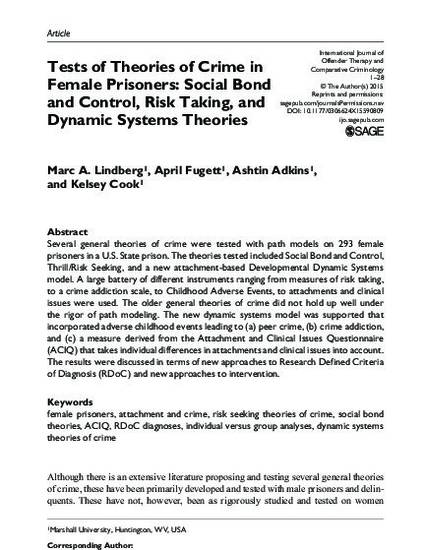
Article
Tests of Theories of Crime in Female Prisoners: Social Bond and Control, Risk Taking, and Dynamic Systems Theories
International Journal of Offender Therapy and Comparative Criminology
(2015)
Abstract
Several general theories of crime were tested with path models on 293 female
prisoners in a U.S. State prison. The theories tested included Social Bond and Control,
Thrill/Risk Seeking, and a new attachment-based Developmental Dynamic Systems
model. A large battery of different instruments ranging from measures of risk taking,
to a crime addiction scale, to Childhood Adverse Events, to attachments and clinical
issues were used. The older general theories of crime did not hold up well under
the rigor of path modeling. The new dynamic systems model was supported that
incorporated adverse childhood events leading to (a) peer crime, (b) crime addiction,
and (c) a measure derived from the Attachment and Clinical Issues Questionnaire
(ACIQ) that takes individual differences in attachments and clinical issues into account.
The results were discussed in terms of new approaches to Research Defined Criteria
of Diagnosis (RDoC) and new approaches to intervention.
Keywords
- female prisoners,
- attachment and crime,
- ACIQ,
- RDoC diagnoses,
- dynamic systems theories of crime
Disciplines
Publication Date
Summer June 19, 2015
DOI
10.1177/0306624X15590809
Citation Information
Marc A. Lindberg. "Tests of Theories of Crime in Female Prisoners: Social Bond and Control, Risk Taking, and Dynamic Systems Theories" International Journal of Offender Therapy and Comparative Criminology Vol. june Iss. 19 (2015) p. 1 - 28 ISSN: 15526933 Available at: http://works.bepress.com/marc_lindberg/9/
Creative Commons license

This work is licensed under a Creative Commons CC_BY-SA International License.
